《链表专题》
1.相交链表
- 方法一常规方法
根据链表A、B的差值,将较长的链表移动 差值的距离,然后两个链表同时向后移动,如果遇到相等的,则返回,否则返回空。
public class Solution {
public ListNode getIntersectionNode(ListNode headA, ListNode headB) {
Integer lengthA = 0;
Integer lengthB = 0;
Integer difference = 0;
ListNode copyA = headA;
ListNode copyB = headB;
while(copyA.next!=null){
copyA = copyA.next;
lengthA++;
}
while(copyB.next!=null){
copyB = copyB.next;
lengthB++;
}
copyA = headA;
copyB = headB;
if(lengthA>=lengthB){
difference = lengthA - lengthB;
while(difference>0){
copyA = copyA.next;
difference--;
}
} else{
difference = lengthB - lengthA;
while(difference>0){
copyB = copyB.next;
difference--;
}
}
while(copyA!=null && copyB!=null){
if(copyA==copyB){
return copyA;
}
copyA = copyA.next;
copyB = copyB.next;
}
return null;
}
}
- 方法二,哈希表
以空间换时间,将链表A的数据存储到哈希表中,循环链表B的数据判断两个链表的数据是否相等。
/**
* Definition for singly-linked list.
* public class ListNode {
* int val;
* ListNode next;
* ListNode(int x) {
* val = x;
* next = null;
* }
* }
*/
public class Solution {
public ListNode getIntersectionNode(ListNode headA, ListNode headB) {
HashSet<ListNode> set = new HashSet<>();
ListNode copyA = headA;
ListNode copyB = headB;
while(copyA!=null){
set.add(copyA);
copyA = copyA.next;
}
while(copyB!=null){
if(set.contains(copyB)){
return copyB;
}
copyB = copyB.next;
}
return null;
}
}
- 方法三:数学,逻辑,思维的方法
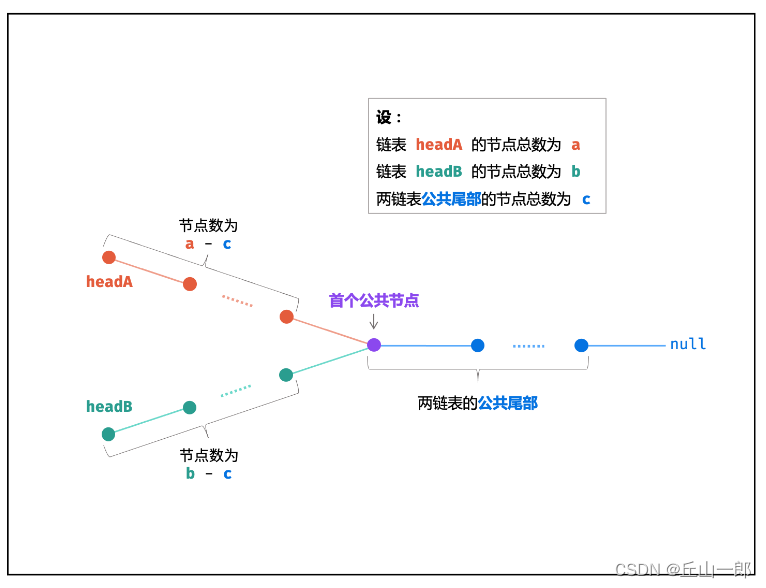

原理:若相交,链表A: a+c, 链表B : b+c. a+c+b+c = b+c+a+c 。则会在公共处c起点相遇。若不相交,a +b = b+a 。因此相遇处是NULL
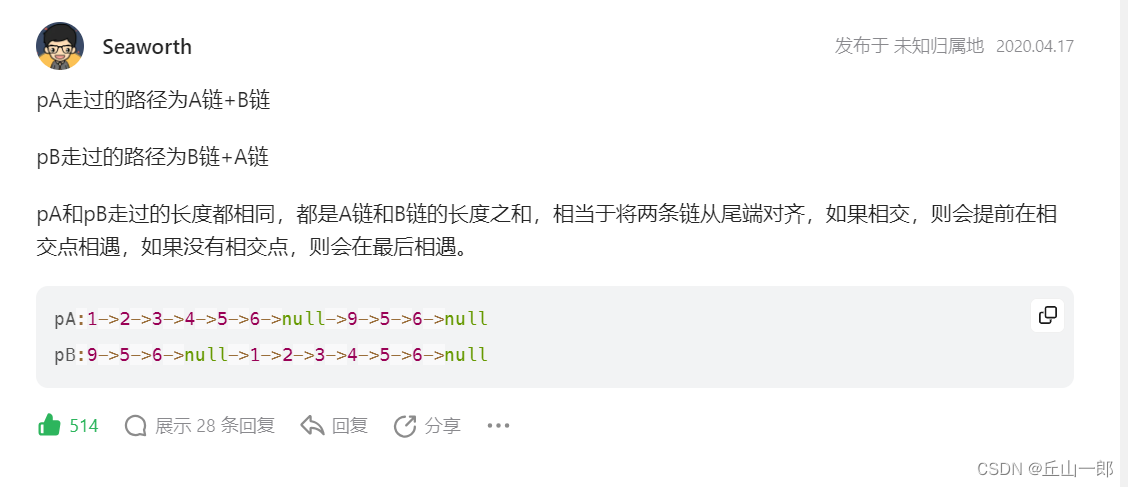
public class Solution {
public ListNode getIntersectionNode(ListNode headA, ListNode headB) {
ListNode nodeA = headA;
ListNode nodeB = headB;
while(nodeA!=nodeB){
nodeA = nodeA==null ? headB : nodeA.next;
nodeB = nodeB==null ? headA : nodeB.next;
}
return nodeA;
}
}
2.反转链表
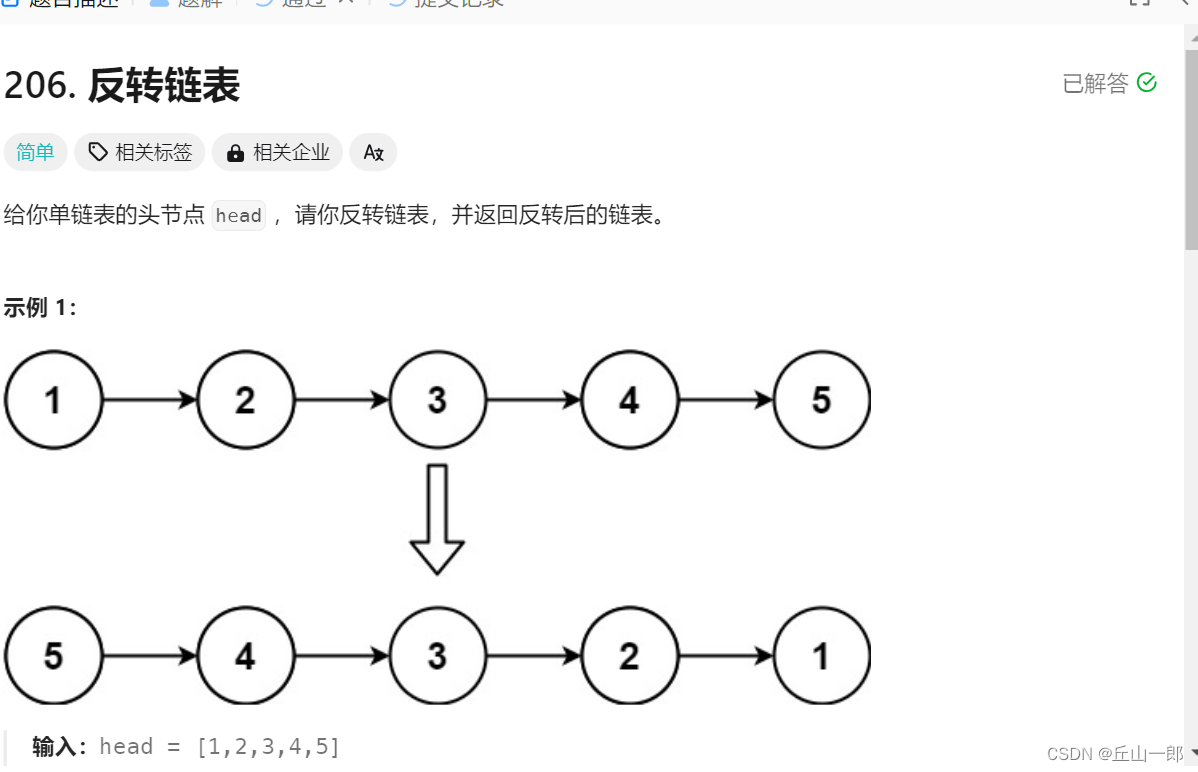
- 常规方法
/**
* Definition for singly-linked list.
* public class ListNode {
* int val;
* ListNode next;
* ListNode() {}
* ListNode(int val) { this.val = val; }
* ListNode(int val, ListNode next) { this.val = val; this.next = next; }
* }
*/
class Solution {
public ListNode reverseList(ListNode head) {
if(head==null||head.next==null){
return head;
}
ListNode newHead = new ListNode(0);
ListNode curNode = head;
while(curNode!=null){
ListNode nextNode = curNode.next;
curNode.next = newHead.next;
newHead.next = curNode;
curNode = nextNode;
}
return newHead.next;
}
}
3.回文链表
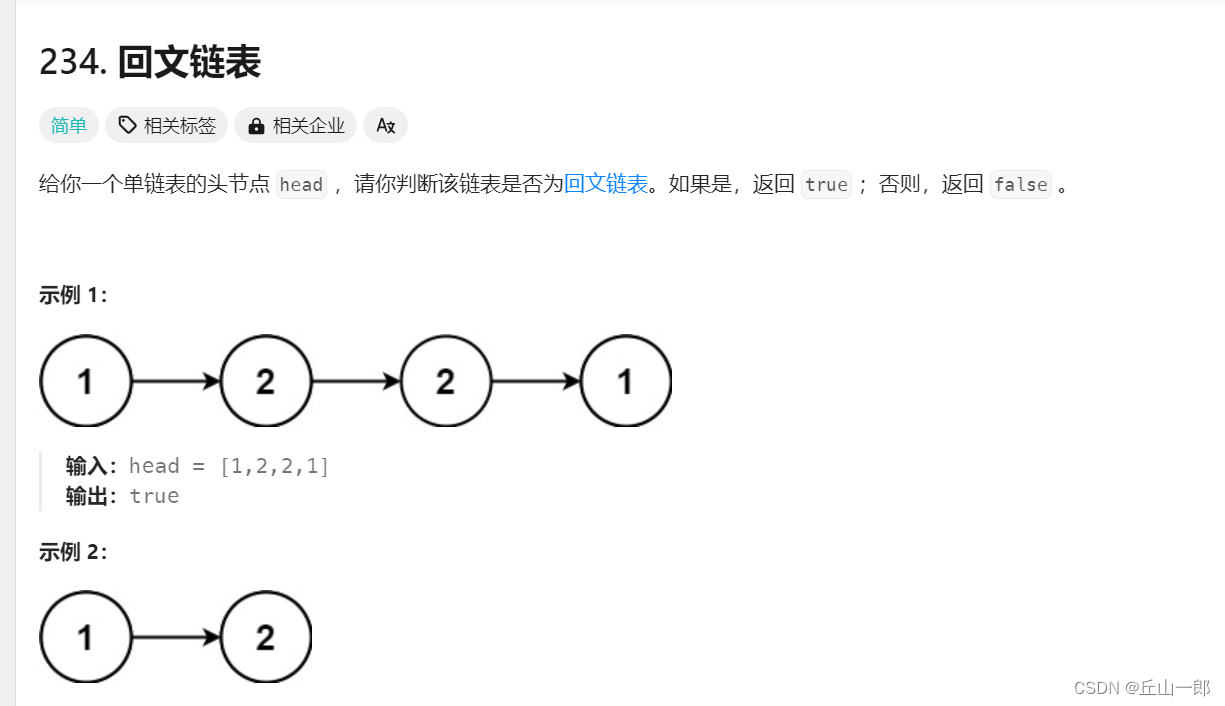
- 方法一 反转后半部分链表
/**
* Definition for singly-linked list.
* public class ListNode {
* int val;
* ListNode next;
* ListNode() {}
* ListNode(int val) { this.val = val; }
* ListNode(int val, ListNode next) { this.val = val; this.next = next; }
* }
*/
class Solution {
public boolean isPalindrome(ListNode head) {
if(head==null || head.next ==null){
return true;
}
int k = 0;
ListNode countNode = head;
while(countNode!=null){
k++;
countNode = countNode.next;
}
ListNode middleHead = head;
// 判断是奇数还是偶数,将链表一分为2
int kk = 0;
if(k%2==0){
kk = k/2;
}else{
kk = k/2+1;
}
while(kk>0){
middleHead = middleHead.next;
kk--;
}
// 链表反转
ListNode newHead = new ListNode(0);
ListNode curNode = middleHead;
while(curNode!=null){
ListNode nextNode = curNode.next;
curNode.next = newHead.next;
newHead.next = curNode;
curNode = nextNode;
}
middleHead = newHead.next;
while(head!=null && middleHead!=null){
if(head.val!=middleHead.val){
return false;
}
head = head.next;
middleHead = middleHead.next;
}
return true;
}
}
- 方法二,以空间换时间
/**
* Definition for singly-linked list.
* public class ListNode {
* int val;
* ListNode next;
* ListNode() {}
* ListNode(int val) { this.val = val; }
* ListNode(int val, ListNode next) { this.val = val; this.next = next; }
* }
*/
class Solution {
public boolean isPalindrome(ListNode head) {
int k = 0;
ListNode curNode = head;
List<ListNode> list = new ArrayList<>();
while(curNode!=null){
list.add(curNode);
k++;
curNode = curNode.next;
}
for(int i=0;i<k/2;i++){
ListNode before = list.get(i);
ListNode after = list.get(k-i-1);
if(before.val != after.val){
return false;
}
}
return true;
}
}
4.环形链表
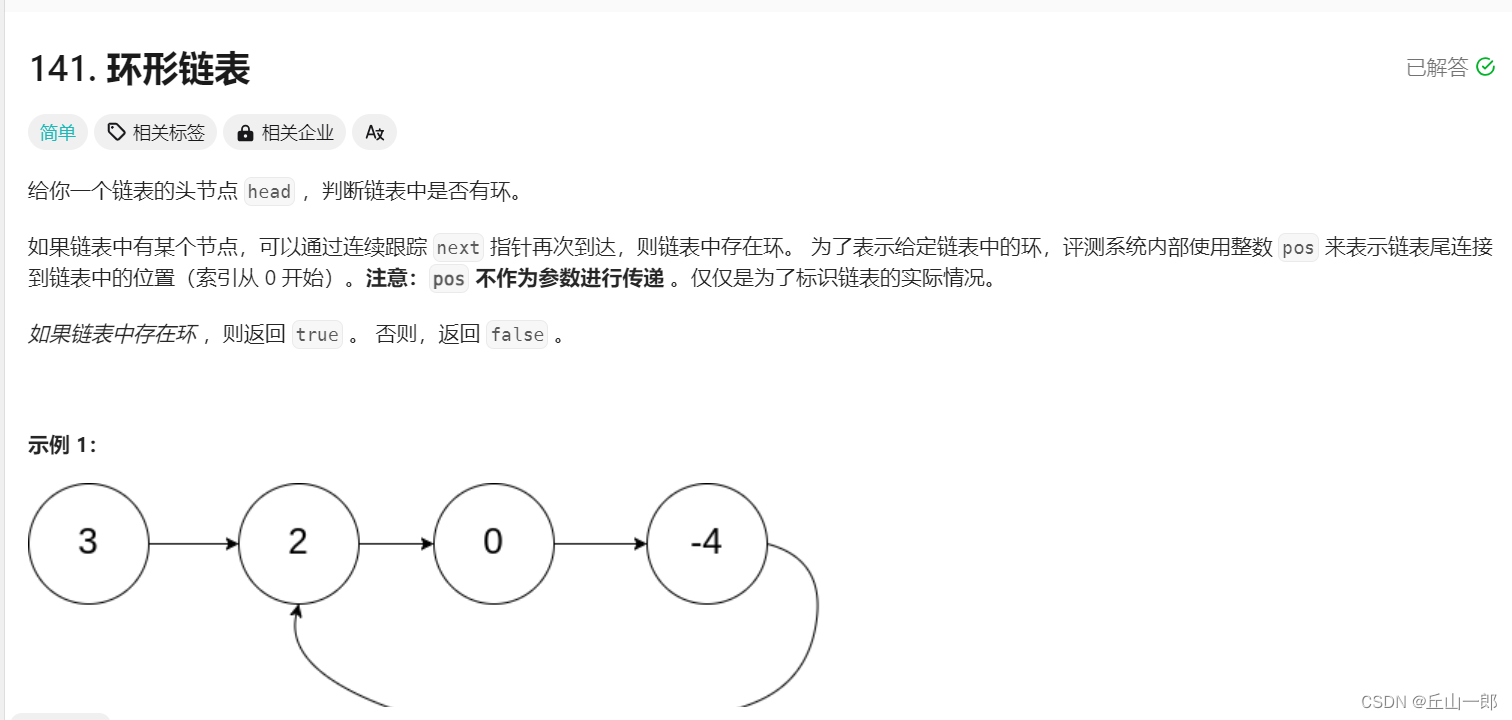
- 方法一:哈希表,ArrayList空间
/**
* Definition for singly-linked list.
* class ListNode {
* int val;
* ListNode next;
* ListNode(int x) {
* val = x;
* next = null;
* }
* }
*/
public class Solution {
public boolean hasCycle(ListNode head) {
if(head==null || head.next==null){
return false;
}
List<ListNode> list = new ArrayList();
while(head!=null){
if(list.contains(head)){
return true;
}
list.add(head);
head= head.next;
}
return false;
}
}
- 方法二:快慢指针

慢指针走过的距离是:a+b+n*(b+c) (b+c其实就是环的长度)
快指针走过的距离是:a+b+m*(b+c)
在相同的时间内快指针走过的距离是慢指针的2倍,所以有
a+b+m*(b+c) = 2*(a+b+n*(b+c))
整理得到
a+b=(m-2n)(b+c),

a+b=(m-2n)(b+c)这里没解释清楚感觉。a+b=(m-2n-1)(b+c)+b+c 两边同事去掉b得 a = (m-2n-1)(b+c) + c => a-c = (m-2n-1)(b+c) => a-c的长度差就是环长度的整数倍。第一种大环的情况下m=1 n=0 => a-c = 0 => a=c.如果一个从相交点开始跑,一个从头结点开始,速度一样,都是一个节点,那么假设相交则有从头开始的路程为a+x(b+c)+b,从相交点开始的路程为c+y(b+c)+b,由于速度一样,故路程一样得 a-c = (x-y)(b+c),也是整数倍,假设成立。
/**
* Definition for singly-linked list.
* class ListNode {
* int val;
* ListNode next;
* ListNode(int x) {
* val = x;
* next = null;
* }
* }
*/
public class Solution {
public boolean hasCycle(ListNode head) {
if(head==null||head.next==null){
return false;
}
// 环境
ListNode slow = head;
ListNode fast = head.next;
while(slow!=fast){
if(fast==null||fast.next==null){
return false;
}
slow = slow.next;
fast = fast.next.next;
}
return true;
}
}
142. 环形链表 II
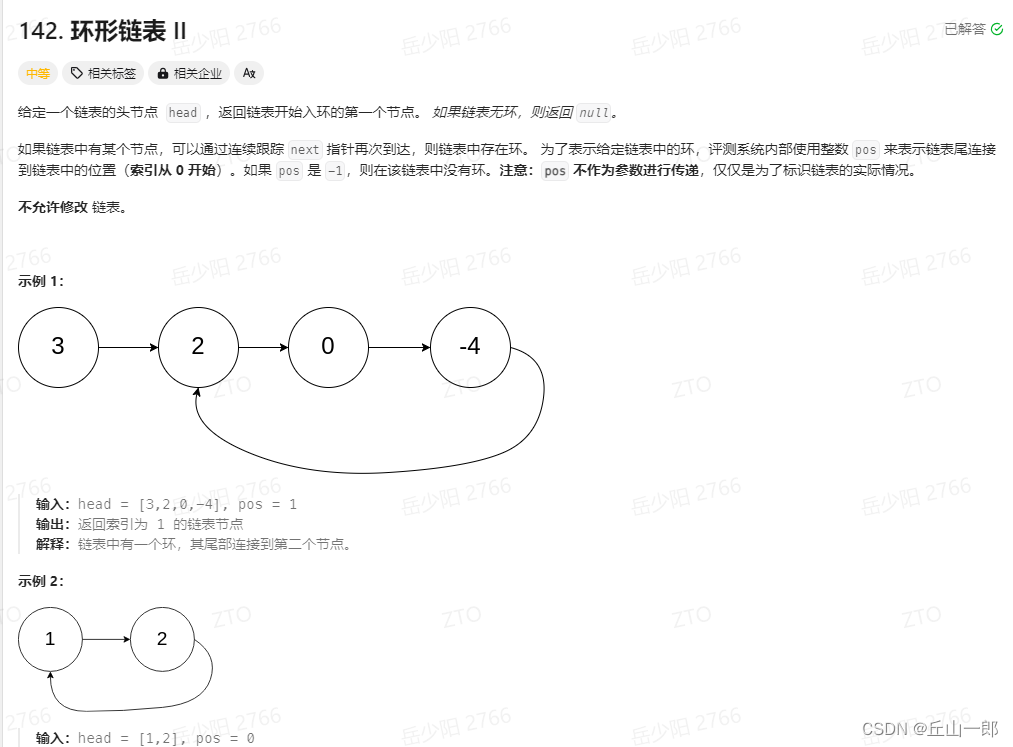
方法一:hashMap集合的方式
/**
* Definition for singly-linked list.
* class ListNode {
* int val;
* ListNode next;
* ListNode(int x) {
* val = x;
* next = null;
* }
* }
*/
public class Solution {
public ListNode detectCycle(ListNode head) {
HashSet<ListNode> set = new HashSet<>();
ListNode node = head;
while(node!=null){
if(set.contains(node)){
return node;
}
set.add(node);
node = node.next;
}
return null;
}
}
方法二:证明理解
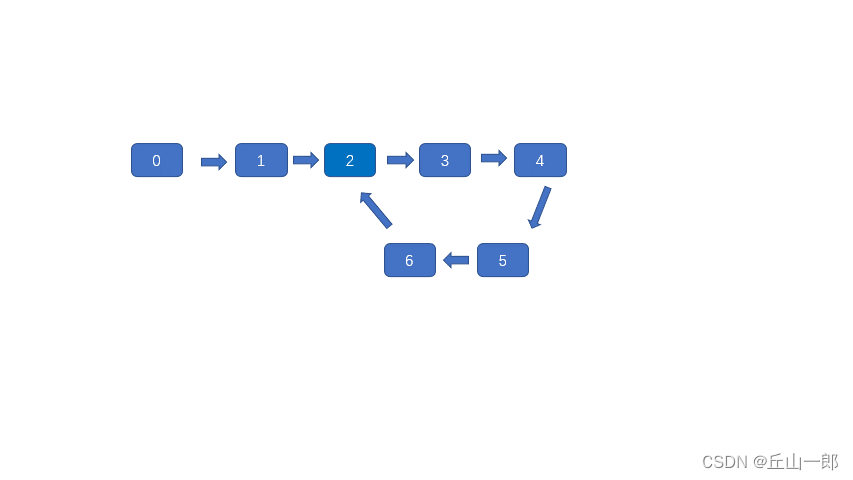

上图黄色节点为快慢指针相遇的节点,此时
快指针走的距离:a+(b+c)n+b
很容易理解b+c为环的长度,a为直线距离,b为绕了n圈之后又走了一段距离才相遇,所以相遇时走的总路程为a+(b+c)n+b,合并同类项得a+(n+1)b+nc。
慢指针走的距离:a+(b+c)m+b,m代表圈数。
然后我们设快指针得速度是慢指针的2倍,含义为相同时间内,快指针走过的距离是慢指针的2倍。
**a+(n+1)b+nc=2[a+(m+1)b+mc]整理得a+b=(n-2m)(b+c),**那么我们可以从这个等式上面发现什么呢?b+c
为一圈的长度。也就是说a+b等于n-2m个环的长度。为了便于理解我们看一种特殊情况,当n-2m等于1,那么a+b=b+c整理得,a=c此时我们只需重新释放两个指针,一个从head释放,一个从相遇点释放,速度相同,因为a=c所以他俩必会在环入口处相遇,则求得入口节点索引。

/**
* Definition for singly-linked list.
* class ListNode {
* int val;
* ListNode next;
* ListNode(int x) {
* val = x;
* next = null;
* }
* }
*/
public class Solution {
public ListNode detectCycle(ListNode head) {
if (head == null || head.next == null) {
return null;
}
ListNode slow = head;
ListNode fast = head;
while (slow != null && fast != null && fast.next != null) {
slow = slow.next;
fast = fast.next.next;
if (slow == fast) {
while (head != null && slow != null) {
if (head == slow) {
return head;
}
head = head.next;
slow = slow.next;
}
}
}
return null;
}
}
21. 合并两个有序链表
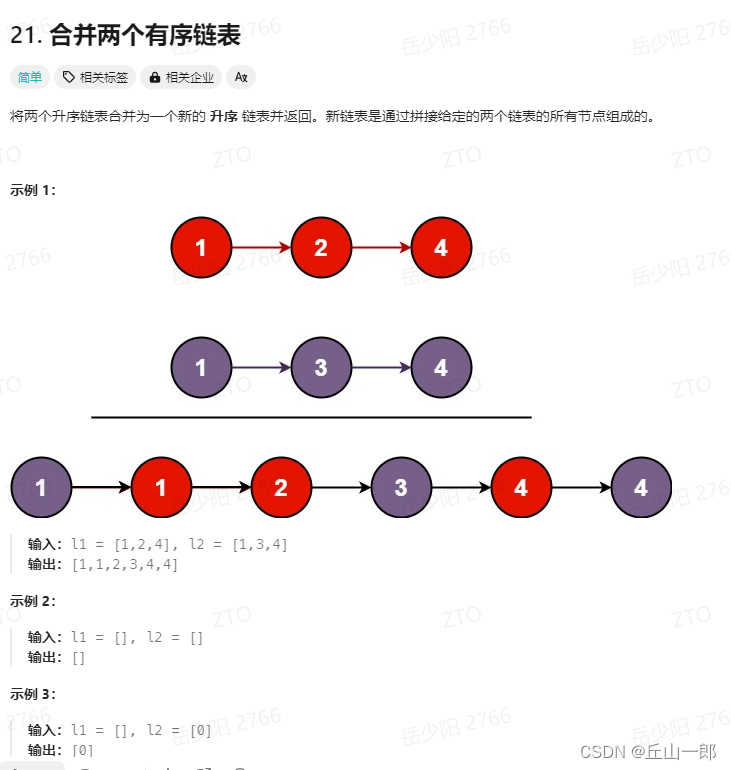
- 常规方法
/**
* 常规方法
*/
class Solution {
public ListNode mergeTwoLists(ListNode list1, ListNode list2) {
if(list1==null){
return list2;
}
if(list2==null){
return list1;
}
// 比较大小
ListNode newHead = new ListNode(0);
ListNode curNode = newHead;
ListNode nodeA = list1;
ListNode nodeB = list2;
while(nodeA!=null && nodeB!=null){
if(nodeA.val<=nodeB.val){
curNode.next = nodeA;
nodeA = nodeA.next;
}else{
curNode.next = nodeB;
nodeB = nodeB.next;
}
curNode = curNode.next;
}
if(nodeA!=null){
curNode.next = nodeA;
}
if(nodeB!=null){
curNode.next = nodeB;
}
return newHead.next;
}
}
19. 删除链表的倒数第 N 个结点
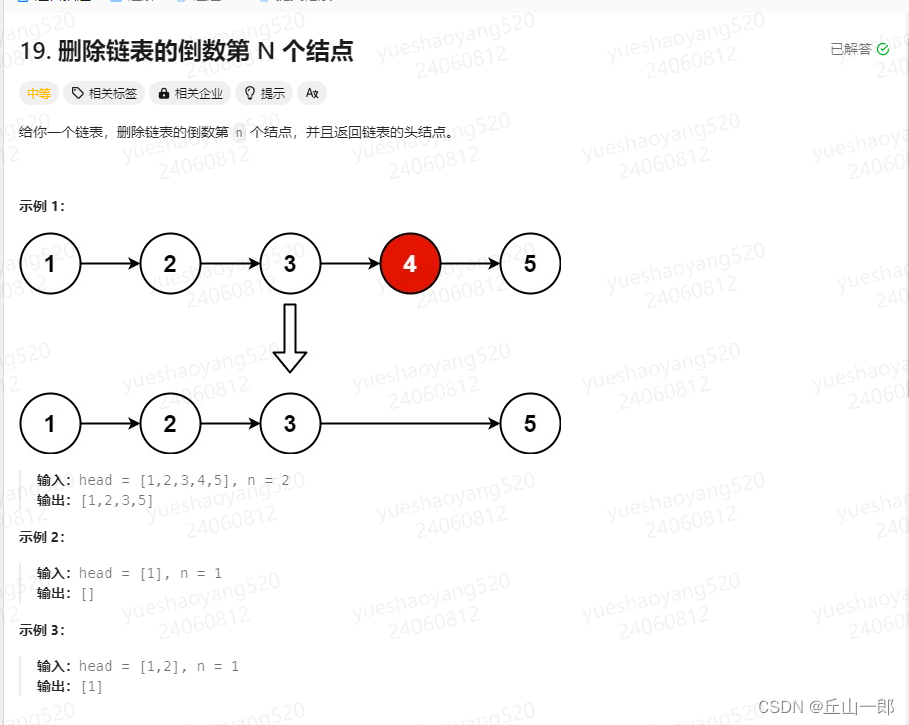
1.先找到 链表的长度,然后根据链表长度获取数据
/**
* Definition for singly-linked list.
* public class ListNode {
* int val;
* ListNode next;
* ListNode() {}
* ListNode(int val) { this.val = val; }
* ListNode(int val, ListNode next) { this.val = val; this.next = next; }
* }
*/
class Solution {
public ListNode removeNthFromEnd(ListNode head, int n) {
int length = 0;
ListNode newHead = new ListNode(0);
newHead.next = head;
ListNode curNode = newHead;
ListNode headNode = head;
while(head!=null){
head = head.next;
length++;
}
int size = length - n ;
while(size>0){
curNode = curNode.next;
size--;
}
curNode.next = curNode.next.next;
return newHead.next;
}
}
二、快慢指针
/**
* Definition for singly-linked list.
* public class ListNode {
* int val;
* ListNode next;
* ListNode() {}
* ListNode(int val) { this.val = val; }
* ListNode(int val, ListNode next) { this.val = val; this.next = next; }
* }
*/
class Solution {
public ListNode removeNthFromEnd(ListNode head, int n) {
// 双指针
ListNode newHead = new ListNode(0);
newHead.next = head;
ListNode curNode = newHead;
ListNode preNode = newHead;
while(n>0){
curNode = curNode.next;
n--;
}
while(curNode.next!=null){
curNode = curNode.next;
preNode = preNode.next;
}
preNode.next = preNode.next.next;
return newHead.next;
}
}
24. 两两交换链表中的节点
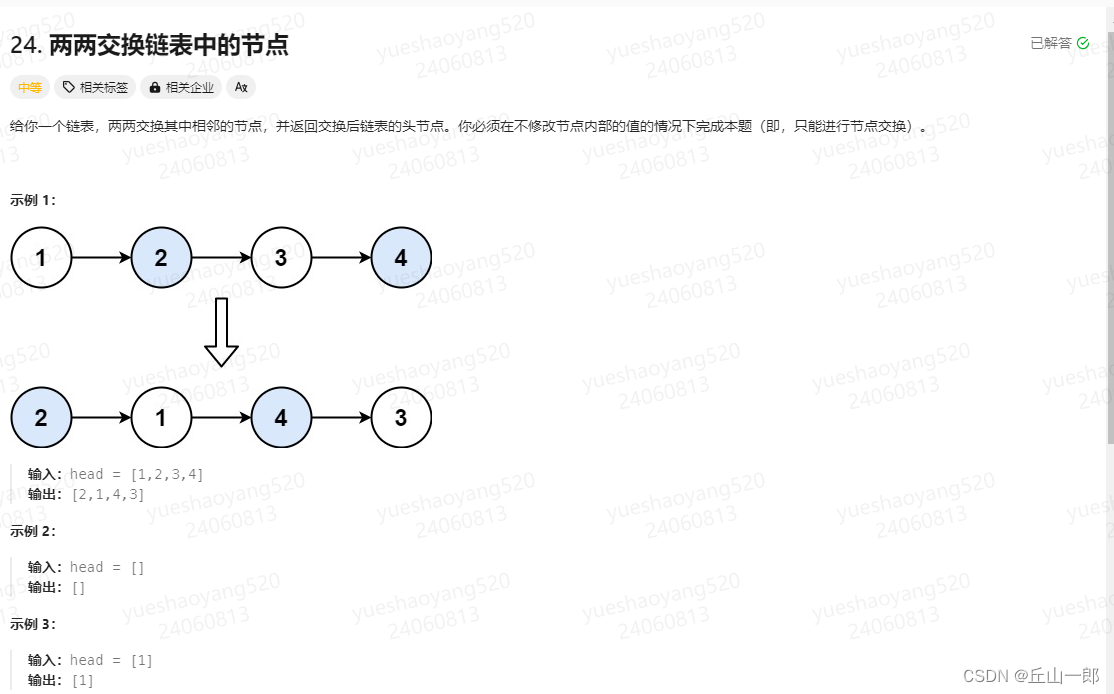
方法一:常规方法 注意边界条件
class Solution {
public ListNode swapPairs(ListNode head) {
if (head == null || head.next == null) {
return head;
}
ListNode newHead = new ListNode(0, head);
ListNode curHead = newHead;
while (curHead.next != null && curHead.next.next != null) {
ListNode one = curHead.next;
ListNode two = curHead.next.next;
ListNode nextNode = two.next;
two.next = one;
one.next = nextNode;
curHead.next = two;
curHead = curHead.next.next;
}
return newHead.next;
}
}
二、递归的方法
class Solution {
public ListNode swapPairs(ListNode head) {
if (head == null || head.next == null) {
return head;
}
ListNode newHead = head.next;
head.next = swapPairs(newHead.next);
newHead.next = head;
return newHead;
}
}
25. K 个一组翻转链表
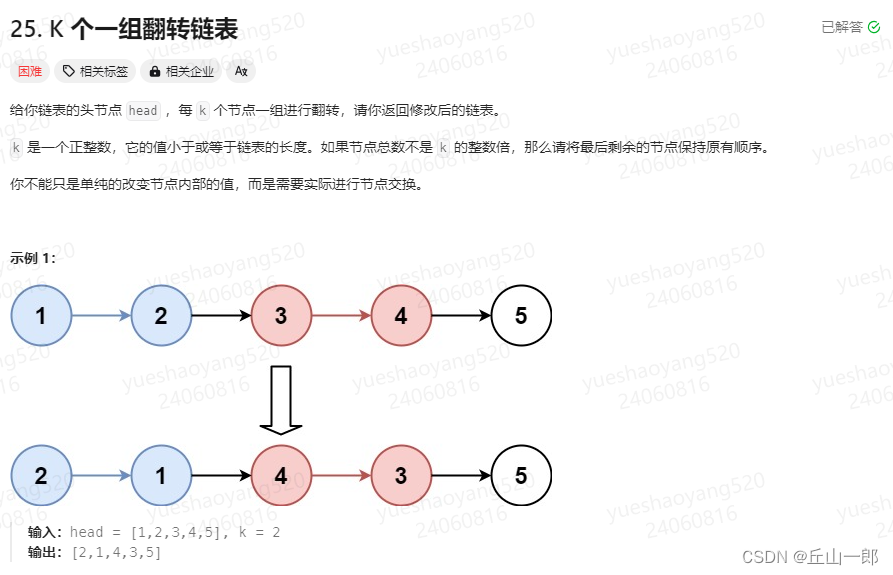
方法一:反转链表升级版
class Solution {
public static ListNode reverseKGroup(ListNode head, int k) {
ListNode newHead = new ListNode(0,head);
ListNode curNode = newHead;
while(curNode!=null&& curNode.next!=null){
// 首先判断是否有k个
int temp = k;
ListNode preNode = curNode;
ListNode originalStartNode = curNode.next;
ListNode endNode = originalStartNode;
while(originalStartNode!=null && temp>0){
curNode = curNode.next;
originalStartNode = originalStartNode.next;
temp--;
}
if(temp>0){
break;
}
// 记录下Next节点
ListNode nextNode = curNode.next;
ListNode startNode = convertNode(endNode,nextNode,k);
preNode.next = startNode;
endNode.next = nextNode;
curNode = endNode;
}
return newHead.next;
}
// 反转链表
public static ListNode convertNode(ListNode startNode, ListNode nextNode, int k){
ListNode head = new ListNode(0);
ListNode curNode = startNode;
while(curNode!=null && k>0){
ListNode next = curNode.next;
curNode.next = head.next;
head.next = curNode;
curNode = next;
k--;
}
return head.next;
}
}
138. 随机链表的复制
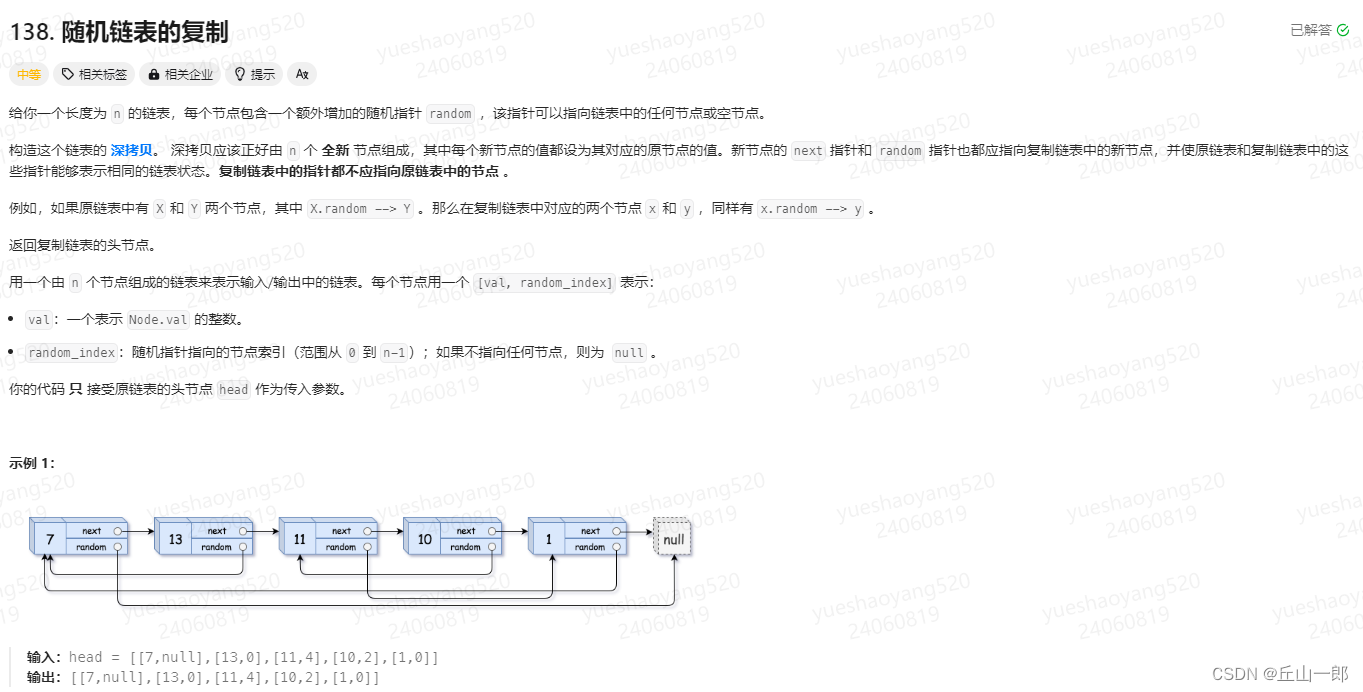
方法一:迭代法
/*
// Definition for a Node.
class Node {
int val;
Node next;
Node random;
public Node(int val) {
this.val = val;
this.next = null;
this.random = null;
}
}
*/
class Solution {
public Node copyRandomList(Node head) {
if (head == null) {
return head;
}
Node node = head;
while (node != null) {
Node tempNode = new Node(node.val);
tempNode.next = node.next;
node.next = tempNode;
node = node.next.next;
}
node = head;
// 循环拷贝
while (node != null) {
if (node.random != null) {
node.next.random = node.random.next;
}
node = node.next.next;
}
node = head;
Node result = head.next;
// 循环链接
Node preNode = head;
Node curNode = head.next;
while (curNode != null && curNode.next != null) {
preNode.next = preNode.next.next;
curNode.next = curNode.next.next;
preNode = preNode.next;
curNode = curNode.next;
}
preNode.next = null;
return result;
}
}
方法二:map
/*
// Definition for a Node.
class Node {
int val;
Node next;
Node random;
public Node(int val) {
this.val = val;
this.next = null;
this.random = null;
}
}
*/
class Solution {
public Node copyRandomList(Node head) {
Map<Node,Node> map = new HashMap<Node,Node>();
// 首先填充数据
Node node = head;
while(node!=null){
Node tempNode = new Node(node.val);
map.put(node,tempNode);
node = node.next;
}
node = head;
while(node!=null){
map.get(node).next = map.get(node.next);
map.get(node).random = map.get(node.random);
node = node.next;
}
return map.get(head);
}
}
148. 排序链表
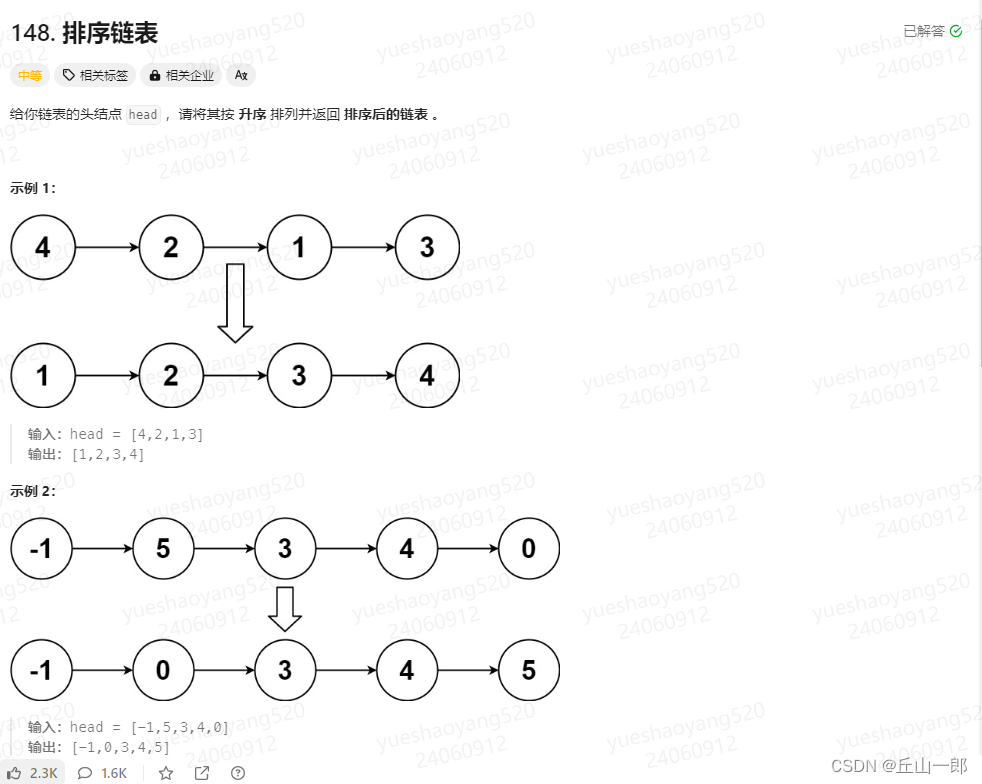
方法一:以时间换空间
/**
* Definition for singly-linked list.
* public class ListNode {
* int val;
* ListNode next;
* ListNode() {}
* ListNode(int val) { this.val = val; }
* ListNode(int val, ListNode next) { this.val = val; this.next = next; }
* }
*/
class Solution {
public ListNode sortList(ListNode head) {
if (head == null || head.next == null) {
return head;
}
int length = 0;
ListNode node = head;
while (node != null) {
node = node.next;
length++;
}
int[] array = new int[length];
int i = 0;
node = head;
while (node != null) {
array[i] = node.val;
node = node.next;
i++;
}
Arrays.sort(array);
ListNode newHead = new ListNode(0);
ListNode finalHead = newHead;
for (int k : array) {
ListNode listNode = new ListNode(k);
newHead.next = listNode;
newHead = newHead.next;
}
return finalHead.next;
}
}
方法二,归并排序 自上而下
/**
* Definition for singly-linked list.
* public class ListNode {
* int val;
* ListNode next;
* ListNode() {}
* ListNode(int val) { this.val = val; }
* ListNode(int val, ListNode next) { this.val = val; this.next = next; }
* }
*/
class Solution {
public ListNode sortList(ListNode head) {
return sortList(head, null);
}
public ListNode sortList(ListNode head, ListNode tail) {
if (head == null) {
return head;
}
if (head.next == tail) {
head.next = null;
return head;
}
ListNode slow = head, fast = head;
while (fast != tail) {
slow = slow.next;
fast = fast.next;
if (fast != tail) {
fast = fast.next;
}
}
ListNode mid = slow;
ListNode list1 = sortList(head, mid);
ListNode list2 = sortList(mid, tail);
ListNode sorted = merge(list1, list2);
return sorted;
}
public ListNode merge(ListNode head1, ListNode head2) {
ListNode dumyHead = new ListNode(0);
ListNode temp = dumyHead, temp1 = head1, temp2 = head2;
while (temp1 != null && temp2 != null) {
if (temp1.val <= temp2.val) {
temp.next = temp1;
temp1 = temp1.next;
} else {
temp.next = temp2;
temp2 = temp2.next;
}
temp = temp.next;
}
if (temp1 != null) {
temp.next = temp1;
} else if (temp2 != null) {
temp.next = temp2;
}
return dumyHead.next;
}
}
方法三:归并排序,自下而上
class Solution {
public ListNode sortList(ListNode head) {
if (head == null) {
return head;
}
int length = 0;
ListNode node = head;
while (node != null) {
length++;
node = node.next;
}
ListNode dummyHead = new ListNode(0, head);
for (int subLength = 1; subLength < length; subLength <<= 1) {
ListNode prev = dummyHead, curr = dummyHead.next;
while (curr != null) {
ListNode head1 = curr;
for (int i = 1; i < subLength && curr.next != null; i++) {
curr = curr.next;
}
ListNode head2 = curr.next;
curr.next = null;
curr = head2;
for (int i = 1; i < subLength && curr != null && curr.next != null; i++) {
curr = curr.next;
}
ListNode next = null;
if (curr != null) {
next = curr.next;
curr.next = null;
}
ListNode merged = merge(head1, head2);
prev.next = merged;
while (prev.next != null) {
prev = prev.next;
}
curr = next;
}
}
return dummyHead.next;
}
public ListNode merge(ListNode head1, ListNode head2) {
ListNode dummyHead = new ListNode(0);
ListNode temp = dummyHead, temp1 = head1, temp2 = head2;
while (temp1 != null && temp2 != null) {
if (temp1.val <= temp2.val) {
temp.next = temp1;
temp1 = temp1.next;
} else {
temp.next = temp2;
temp2 = temp2.next;
}
temp = temp.next;
}
if (temp1 != null) {
temp.next = temp1;
} else if (temp2 != null) {
temp.next = temp2;
}
return dummyHead.next;
}
}
作者:力扣官方题解
链接:https://leetcode.cn/problems/sort-list/solutions/492301/pai-xu-lian-biao-by-leetcode-solution/
来源:力扣(LeetCode)
著作权归作者所有。商业转载请联系作者获得授权,非商业转载请注明出处。
23. 合并 K 个升序链表
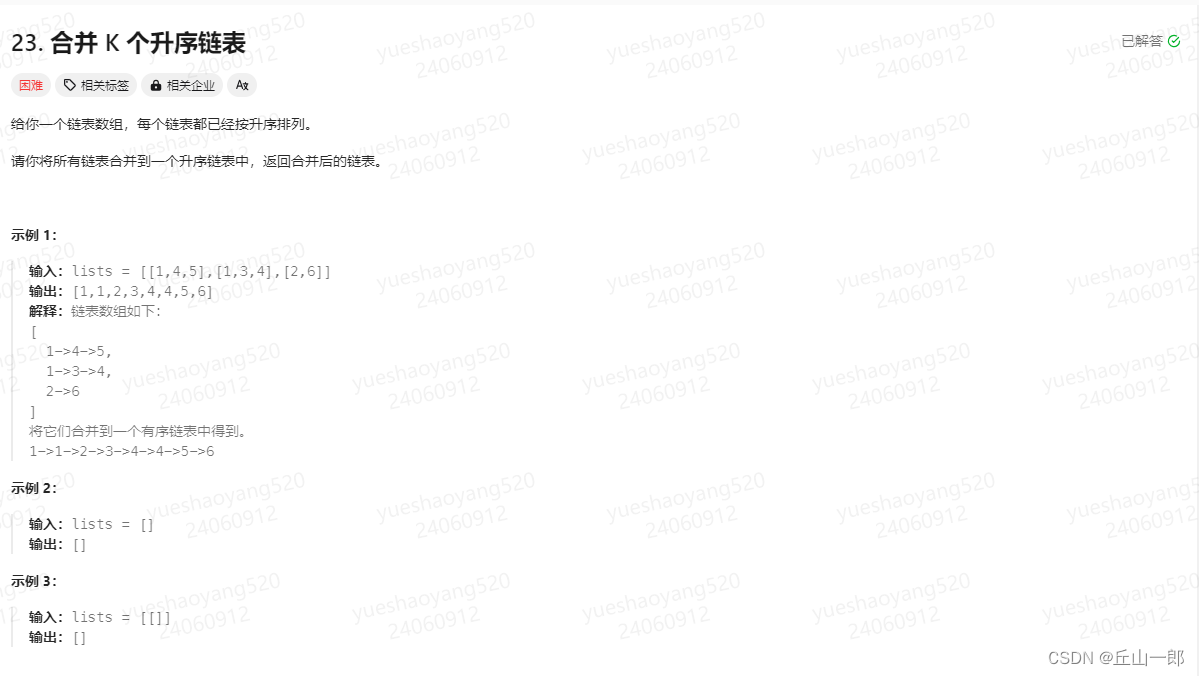
方法一:常规方法
/**
* Definition for singly-linked list.
* public class ListNode {
* int val;
* ListNode next;
* ListNode() {}
* ListNode(int val) { this.val = val; }
* ListNode(int val, ListNode next) { this.val = val; this.next = next; }
* }
*/
class Solution {
public ListNode mergeKLists(ListNode[] lists) {
if(lists.length==0){
return null;
}
if(lists.length==1){
return lists[0];
}
// 循环合并两个有序链表
ListNode ans = null;
for(int i =0;i<lists.length;i++){
ans = mergeSort(ans,lists[i]);
}
return ans;
}
public ListNode mergeSort(ListNode one, ListNode two) {
if (one == null) {
return two;
}
if (two == null) {
return one;
}
ListNode listOne = one;
ListNode listTwo = two;
ListNode node= new ListNode(0);
ListNode newHead = node;
while (listOne != null && listTwo != null) {
if (listOne.val <= listTwo.val) {
newHead.next = listOne;
listOne = listOne.next;
} else {
newHead.next = listTwo;
listTwo = listTwo.next;
}
newHead = newHead.next;
}
if (listOne != null) {
newHead.next = listOne;
}
if (listTwo != null) {
newHead.next = listTwo;
}
return node.next;
}
}
方法二、常规方法升级版
class Solution {
public ListNode mergeKLists(ListNode[] lists) {
return merge(lists, 0, lists.length - 1);
}
public ListNode merge(ListNode[] lists, int l, int r) {
if (l == r) {
return lists[l];
}
if (l > r) {
return null;
}
int mid = (l + r) >> 1;
return mergeTwoLists(merge(lists, l, mid), merge(lists, mid + 1, r));
}
public ListNode mergeTwoLists(ListNode a, ListNode b) {
if (a == null || b == null) {
return a != null ? a : b;
}
ListNode head = new ListNode(0);
ListNode tail = head, aPtr = a, bPtr = b;
while (aPtr != null && bPtr != null) {
if (aPtr.val < bPtr.val) {
tail.next = aPtr;
aPtr = aPtr.next;
} else {
tail.next = bPtr;
bPtr = bPtr.next;
}
tail = tail.next;
}
tail.next = (aPtr != null ? aPtr : bPtr);
return head.next;
}
}
作者:力扣官方题解
链接:https://leetcode.cn/problems/merge-k-sorted-lists/solutions/219756/he-bing-kge-pai-xu-lian-biao-by-leetcode-solutio-2/
来源:力扣(LeetCode)
著作权归作者所有。商业转载请联系作者获得授权,非商业转载请注明出处。
146. LRU 缓存
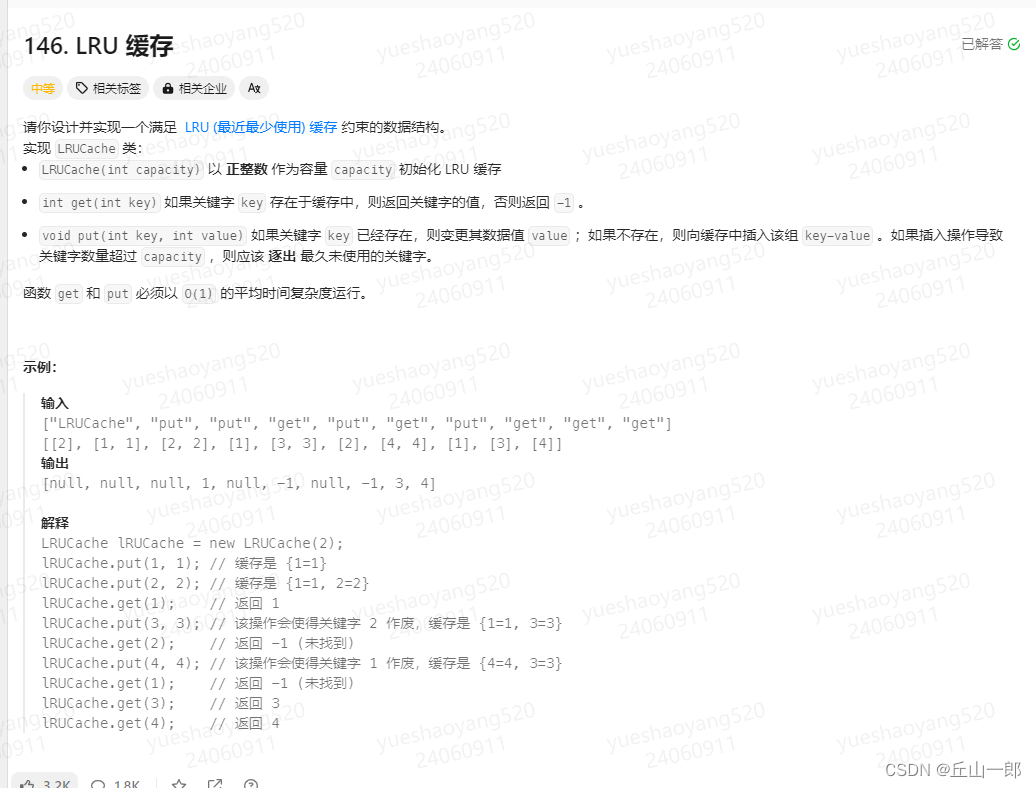
方法一:参考宫水三叶 双链表 + map
class LRUCache {
class Node {
int k, v;
Node l, r;
Node(int _k, int _v) {
k = _k;
v = _v;
}
}
int n;
Node head, tail;
Map<Integer, Node> map;
public LRUCache(int capacity) {
n = capacity;
map = new HashMap<>();
head = new Node(-1, -1);
tail = new Node(-1, -1);
head.r = tail;
tail.l = head;
}
public int get(int key) {
if (map.containsKey(key)) {
Node node = map.get(key);
refresh(node);
return node.v;
}
return -1;
}
public void put(int key, int value) {
Node node = null;
// 首先判断数据是否存在
if (map.containsKey(key)) {
node = map.get(key);
node.v = value;
} else {
if (map.size() == n) {
Node del = tail.l;
map.remove(del.k);
del(del);
}
node = new Node(key, value);
map.put(key, node);
}
refresh(node);
}
public void refresh(Node node) {
del(node);
// 插入头部
node.r = head.r;
head.r = node;
node.l = head;
node.r.l = node;
}
public void del(Node node) {
if (node.l == null) {
return;
}
node.l.r = node.r;
node.r.l = node.l;
}
}
/**
* Your LRUCache object will be instantiated and called as such:
* LRUCache obj = new LRUCache(capacity);
* int param_1 = obj.get(key);
* obj.put(key,value);
*/






















 2564
2564











 被折叠的 条评论
为什么被折叠?
被折叠的 条评论
为什么被折叠?








